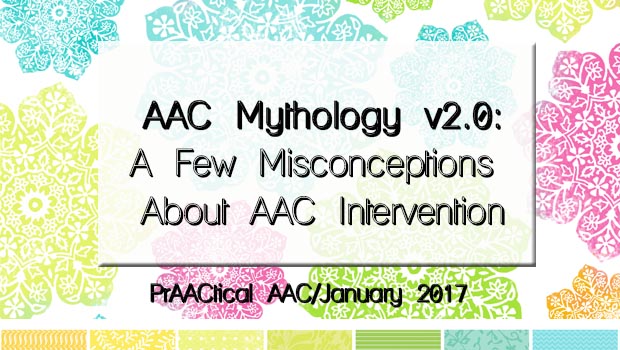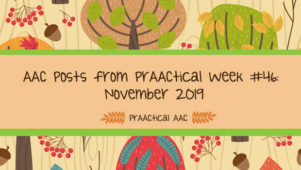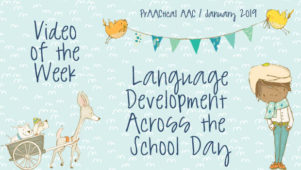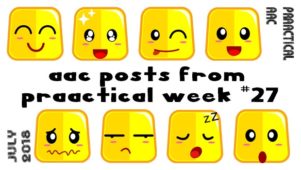AAC Mythology v2.0: A Few Misconceptions About AAC Intervention

The good news is this: A growing number of people with complex communication needs are getting access to AAC.
Educators whose students had AAC only at circle and snack time are now using it more consistently with their students throughout the day and teaching lessons specifically designed to build skills with AAC systems. SLPs who had eschewed AAC or who had focused their AAC efforts on choicemaking, requesting, and labeling are now embracing their role as language specialists and teaching a fuller array of semantic, morphological, and syntactic skills to AAC learners. AT specialists who had been doling out the same few SGDs and AAC apps are now digging deeper and using established practices for AT selection in supporting minimally verbal and nonverbal students. Behaviorists who had previously focused primarily on receptive identification and verbal imitation are supporting the expressive needs of their clients in new ways. Families who had little or no idea of how to support their children with AAC needs are educating and empowering themselves to provide communication models throughout the day.
More people using AAC supports is a good thing.
We celebrate the bigger tent because it means that more children and adults with significant communication challenges will have a voice. But when there is an influx of practitioners who are on their way up the AAC learning curve, there are bound to be some constructs that are understood on a superficial level, concepts that are misinterpreted, and practices based on faulty assumptions. I think of them as growing pains.
Some of these growing pains have become widespread and have developed into the new myths of AAC. Here are thoughts on a few of them.
Core vocabulary = The only vocabulary
The job of AAC is to allow people to talk about whatever matters to them. Core vocabulary is powerful because it is flexible enough to be used in any circumstance and because it allows us to build sentences and stories. But unless we provide access to the specific words for things they care about, we’re not likely to maximize learning outcomes. An AAC system without words for things that are important to us (coffee! John! beach! podcast! New York Times!) is incomplete.
Core vocabulary = First vocabulary
There is scant evidence that people with complex communication needs learn language using a different process or following a different pattern than the ones used by speaking people. In typical language development, first words generally include people (e.g., Mama, Dada, Nana) and other nouns (e.g., doggy, baby, kitty, duck) that may not be considered core vocabulary. Of course, they also include verbs (e.g., do, see, go, stop), negation (i.e., no, don’t), determiners (i.e., this, that), descriptors (e.g., good), prepositions (e.g., in), and social words (e.g., bye-bye, hi, uh-oh) that ARE core vocabulary. It’s important to recognize, though, that AAC core vocabulary lists are NOT a prescription for what words to teach first. Core vocabulary lists are lists of high-frequency words for a certain age group. Just because speaking toddlers, for example, (Banajee, DiCarlo, & Stricklin, 2003) said those words more often than other words doesn’t mean these are the words we automatically teach first. Instead, think of these lists as things that inform the decision rather than define it. The learner’s specific interests and other factors are important to consider, too.
Modeling AAC = Teaching AAC
Modeling AAC (aided language input) is a critical element of good AAC instruction. People who are developing language through AAC, like second language learners, do best when immersed in an environment where people are speaking AAC all day long. By itself, however, aided language input is not likely to result in effective language development for many AAC users. In most cases, they will also need us to do things like create specific communication opportunities, provide repetition with variety, respond with effective feedback, and engage in explicit instruction. Modeling AAC is important, but think of it as a starting point.
Moving Beyond the New AAC Myths
In my way of thinking, these new myths that have emerged are not things for us to despair about. No gnashing of teeth is required and we don’t need to separate into distinct camps. These new AAC myths are symptoms of growth. When we develop new ways of thinking and doing, we don’t get it 100% right at the beginning. If you or your team has adopted a myth or two, there’s no need to feel guilty or get caught up in drama. Growing pains are normal outcomes of a very good thing: Growth.
Here’s the thing about growing pains: In healthy organisms, they don’t last. They are temporary conditions. Phases. Stepping stones. With information, guidance, experience, and encouragement, we can refine our AAC practices to gain more positive outcomes and help others to do the same.
What about your tent? Are there AAC growing pains where you live, work, and practice? What other things should we address?

Filed under: Featured Posts, PrAACtical Thinking
Tagged With: intervention, language development, myth
This post was written by Carole Zangari





4 Comments
Thanks Carole! A needed clarification that indicates we’ve grown substantially in the last few years! It’s good to see that the old myths have been more widely recognized. These new myths are practices that are simply an overgenerous move away from the AAC myths that trapped us in the past. Progress!!!
An excellent dialogue for reflecting on where we are on our AAC journies!! This is perfectly explicit as a starting point for productive conversations to guide “what’s next”.
EXCELLENT article! Thanks for giving me some talking points with others!
We can all understand that AAC users will learn how to effectively use their AAC system when they see it used regularly and reliably by others in their world.